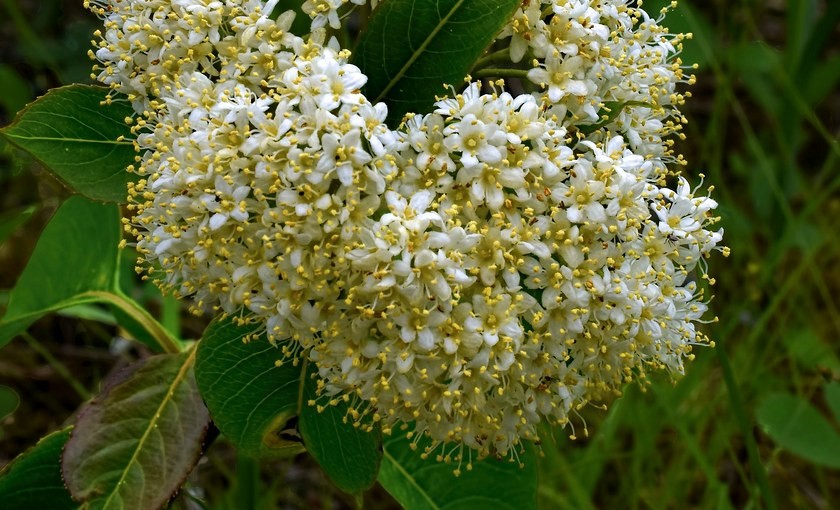Nannyberry
(Viburnum prunifolium)

Description
Viburnum lentago, the nannyberry, sheepberry, or sweet viburnum, is a species of Viburnum native to North America. It is a large shrub or small tree growing upwards to 9 m (30 ft) tall with a trunk up to 25 cm (10 in) in diameter and a short trunk, round-topped head, pendulous, flexible branches. The bark is reddish- to grayish-brown, and broken into small scales. The twigs are pale green and covered with rusty down at first, later becoming dark reddish brown, sometimes glaucous, smooth, tough, flexible, and produce an offensive odor when crushed or bruised. The winter buds are light red, covered with pale scurfy down, protected by a pair of opposing scales. Flower-bearing buds are 2 cm (3⁄4 in) long, obovate, long pointed; other terminal buds are acute, 8.5 to 12.7 mm (1⁄3 to 1⁄2 in) long, while lateral buds are much smaller. The bud scales enlarge with the growing shoot and often become leaf-like. Like all viburnums, the leaves are arranged in opposite pairs on the twigs; they are oval, 5–10 cm (2–4 in) long and 2–5 cm (3⁄4–2 in) broad, wedge-shaped, rounded or subcordate at base, with an acuminate apex and a finely serrated margin, and a winged petiole. They open from the bud involute, bronze green and shining, hairy and downy; when full grown are bright green and shining above, pale green and marked with tiny black dots beneath. In autumn they turn a deep red, or red and orange. The flowers are small, 5–6 mm (0.20–0.24 in) in diameter, with five whitish petals, arranged in large round terminal cymes 5–12 cm (2–4+3⁄4 in) in diameter; flowering is in late spring. The calyx is tubular, equally five-toothed, persistent; the corolla is equally five-lobed, imbricate in the bud, cream-white, one-quarter of an inch across; lobes acute, and slightly erose. There are five stamens, inserted on the base of the corolla, alternate with its lobes, exserted; filaments slender; anthers bright yellow, oblong, introrse, versatile, two-celled; cells opening longitudinally. The pistil has a one-celled inferior ovary, the style thick, short, light green, and the stigma broad; there is one ovule in each cell. The fruit is a small round blue-black drupe, 8–16 mm (0.31–0.63 in) long on a reddish stem; it is thick-skinned, sweet, and rather juicy. The stone is oblong oval, flattened. The roots are fibrous. The wood is ill-smelling, dark orange brown, heavy, hard, close-grained, with a specific gravity of 0.7303.
Taxonomic tree:







